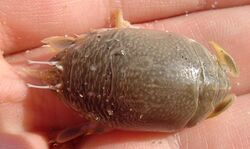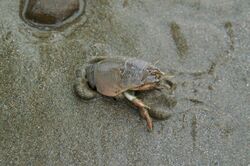Biology:Emerita (crustacean)
| Emerita | |
|---|---|

| |
| Female Emerita analoga | |
| Scientific classification | |
| Domain: | Eukaryota |
| Kingdom: | Animalia |
| Phylum: | Arthropoda |
| Class: | Malacostraca |
| Order: | Decapoda |
| Suborder: | Pleocyemata |
| Infraorder: | Anomura |
| Family: | Hippidae |
| Genus: | Emerita Scopoli, 1777 [1] |
| Type species | |
| Cancer emeritus | |
Emerita is a small genus of decapod crustaceans,[3] known as sand crabs, or mole crabs. These small animals burrow in the sand in the swash zone and use their antennae for filter feeding.[4][5]
Description
Emerita has a barrel-shaped body. It has a tough exoskeleton and can hold its appendages close to the body, allowing it to roll in the tidal currents and waves.[6] It has feathery antennae, which are used to filter plankton and detritus from the swash.[6]
Males are typically smaller than females, and in some species, such as Emerita rathbunae, the minute males live attached to the legs of the female.[7] Females are around 8–37 mm (0.31–1.46 in) in carapace length, depending on the species, while males vary from a similar size to females in E. austroafricana, down to 2.5 mm (0.098 in) carapace length in E. rathbunae and E. talpoida.[8]
Distribution
The genus as a whole has a broad distribution in tropical and subtropical regions. Most individual species, however, are restricted to smaller areas, and their ranges rarely overlap.[9] The genus is common on both coasts of the United States and along the Atlantic coast of Africa; the related genus Hippa is found across the Indo-Pacific, including Australia .[10]
Species
Twelve species are recognised:[3][Note 1]
- Emerita almeidai Mantelatto & Balbino in Mantelatto, Paixão, Robles, Teles & Balbino 2023
- (Stimpson, 1857) – western North America and western South America Schmitt, 1935 – Gulf of Mexico
- Niazi & Haque, 1974 – Pakistan Emerita portoricensis
- Emerita brasiliensis Schmitt, 1935 – Caribbean Sea
- Emerita austroafricana Schmitt, 1935 – southeastern Brazil and northeastern Brazil
- Schmitt, 1935 – western Central America Emerita taiwanensis
- Emerita emeritus Hsueh, 2015
- Emerita analoga Schmitt, 1937 – southeastern Africa and Madagascar
- (Linnaeus, 1767) – South Asia and Southeast Asia (Say, 1817) – eastern North America
- Emerita holthuisi Emerita benedicti
- Sankolli, 1965 – western India, Persian Gulf, and Red Sea Emerita talpoida
- Emerita rathbunae Emerita karachiensis
The Old World species had been widely thought to form a monophyletic group, as did the New World species. The use of molecular phylogenetics has shown, however, that E. analoga, a species living along the Pacific coast of North America, is more closely related to African species than it is to other New World species.[9]
Taxonomy
The genus Emerita was erected by Giovanni Antonio Scopoli in his 1777 work Introductio ad Historiam Naturalem.[11] The type species is Cancer emeritus (now E. emeritus), because at one time, it was the only species in the genus.[2] Other genera with the same name have been rejected for nomenclatural purposes; these were published by Laurens Theodorus Gronovius (1764) and Friedrich Christian Meuschen (1778 and 1781).[1]
Ecology and behaviour
Emerita is adept at burrowing, and is capable of burying itself completely in 1.5 seconds.[6] Unlike mud shrimp, Emerita burrows tail-first into the sand, using the pereiopods to scrape the sand from underneath its body.[12] During this action, the carapace is pressed into the sand as anchorage for the digging limbs.[12] The digging requires the sand to be fluidised by wave action, and Emerita must bury itself in the correct orientation before the wave has passed to be safe from predators.[12]
As the tide changes, Emerita changes its position on the beach;[6] most individuals stay in the zone of breaking waves.[7] This may be detected by the physical characteristics of the sand. As the tide falls, the sand is allowed to settle; when Emerita detects this, it uses the temporary liquefaction from a breaking wave to emerge from its burrow, and is carried down the beach by the wave action.[7] Longshore drift may also drag Emerita laterally along a beach.[7]
The main predators of Emerita are fish; in the eastern Pacific Ocean, the barred surfperch (Amphistichus argenteus) is particularly important.[7] Seabirds also eat Emerita, but do not appear to target the aggregations of mole crabs.[7] Carcasses of Emerita provide an important food source for the closely related scavenger Blepharipoda.[7]
Relationship to humans
Due to the Emerita being the predominant diet of the barred surfperch, surf fishermen use sand crabs as bait. Soft-shelled Emerita are kept also as bait by commercial fisheries.
In some cultures, sand crabs are eaten as a popular snack, such as in Thailand. They are often prepared via shallow frying in a pan or deep frying in batter. The taste is often described as falling somewhere between that of shrimp and crab. Eating sand crabs presents a risk of paralytic shellfish poisoning and/or infection with Profilicollis parasites.[13] In Malaysia, the sand crab locally known as yat yat, ibu remis, kutu laut or udang pasir can be found along the beaches in Kelantan during the monsoon season. The crab is a local delicacy that is usually fried with eggs or roasted on a skewer like satay.[14]
Life cycle
Emerita has a short lifespan, perhaps no more than two to three years, and can reproduce in its first year of life.[7] The eggs are bright orange, and hatch into larvae, which may live as plankton for more than four months and can be carried long distances by ocean currents.[7] The number of zoeal stages varies between species from six to eleven.[2]
See also
Notes
References
- ↑ 1.0 1.1 International Commission on Zoological Nomenclature (1963). "Opinion 643. Idotea Fabricius, 1798, and Mesidotea Richardson, 1905 (Crustacea, Decapoda); validation under the Plenary Powers". Bulletin of Zoological Nomenclature 20 (1): 18–25. http://biostor.org/reference/2147.
- ↑ 2.0 2.1 2.2 Christopher B. Boyko; Patsy A. McLaughlin (2010). "Annotated checklist of anomuran decapod crustaceans of the world (exclusive of the Kiwaoidea and families Chirostylidae and Galatheidae of the Galatheoidea): Part IV – Hippoidea". Zootaxa Suppl. 23: 109–129. http://rmbr.nus.edu.sg/rbz/biblio/s23/s23rbz139-151.pdf.
- ↑ 3.0 3.1 DecaNet (2023). "Emerita Scopoli, 1777". WoRMS. World Register of Marine Species. http://www.marinespecies.org/aphia.php?p=taxdetails&id=158392.
- ↑ Sand Fleas (Mole Crabs or Sand Crabs) Prime surf fishing bait
- ↑ http://www.baymoon.com/~ilga/crabs/ All About Mole Crabs
- ↑ 6.0 6.1 6.2 6.3 Kenneth Henry Mann (2000). "Sandy beaches". Ecology of Coastal Waters, with Implications for Management. Volume 8 of Studies in Ecology (2nd ed.). Wiley-Blackwell. pp. 218–236. ISBN 978-0-86542-550-7. https://books.google.com/books?id=4lWl-0Rsi5MC&pg=PA228.
- ↑ 7.0 7.1 7.2 7.3 7.4 7.5 7.6 7.7 7.8 Edward F. Ricketts; Jack Calvin; David W. Phillips; Joel W. Hedgpeth (1992). "Open-coast sandy beaches". Between Pacific Tides (5th ed.). Stanford University Press. pp. 249–265. ISBN 978-0-8047-2068-7.
- ↑ T. Subramoniam (1981). "Protandric hermaphroditism in a mole crab, Emerita asiatica (Decapoda:Anomura)". Biological Bulletin 160 (1): 161–174. doi:10.2307/1540910. BIOSTOR 9638. https://www.biodiversitylibrary.org/partpdf/14655.
- ↑ 9.0 9.1 9.2 Haye, Pilar A.; Yan K. Tam; Irv Kornfield (2002). "Molecular phylogenetics of mole crabs (Hippidae: Emerita)" (PDF). Journal of Crustacean Biology 22 (4): 903–915. doi:10.1651/0278-0372(2002)022[0903:MPOMHE2.0.CO;2]. http://digitalcommons.library.umaine.edu/cgi/viewcontent.cgi?article=1076&context=sms_facpub.
- ↑ Colin Little (2000). "The coarse extreme: life on sandy beaches". The Biology of Soft Shores and Estuaries. Oxford University Press. pp. 35–57. ISBN 978-0-19-850426-9. https://books.google.com/books?id=wKyGWAUgWXIC&pg=PA36.
- ↑ Ioannis Ant. Scopoli (1777) (in la). Introductio ad historiam naturalem sistens genera lapidum, plantarum, et animalium hactenus detecta, caracteribus essentialibus donata, in tribus divisa, subinde ad leges naturae. Prague: Wolfgang Gerle. https://www.biodiversitylibrary.org/item/42076.
- ↑ 12.0 12.1 12.2 Adolf Seilacher (2007). "Plate 21. Burrowing techniques". Trace Fossil Analysis. Springer. p. 64. ISBN 978-3-540-47225-4. https://books.google.com/books?id=6IlYZ7ZvkaIC&pg=PA64.
- ↑ Lombard, Kirk (2016). The sea forager's guide to the Northern California coast. Leighton Kelly. Berkeley, California. ISBN 978-1-59714-357-8. OCLC 948549931. https://www.worldcat.org/oclc/948549931.
- ↑ Nor Amalina Alias (13 December 2020). "Seronok kutip Yat Yat [METROTV"] (in ms). Harian Metro. https://www.hmetro.com.my/mutakhir/2020/12/652735/seronok-kutip-yat-yat-metrotv.
External links
Wikidata ☰ Q2716660 entry
 |



